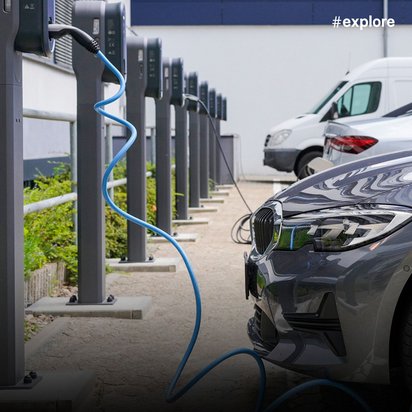Electromobility
The electric car as a fire risk?
How safe is an electric car?

Electromobility
How safe is an electric car?

29. July 2021
The number of registrations of electric vehicles is currently going through the roof – boosted by the increased subsidy premiums and an ever-growing selection of models. One in five new cars in 2021 was an electric car or a plug-in hybrid. As they grow in popularity, discussions about their safety continue to create a stir. In March, electric vehicles were temporarily banned from underground car parks in Kulmbach, Bavaria – due to an alleged increase in the associated fire risk. Roger Eggers from TÜV NORD explains exactly where things stand with the safety of electric vehicles.
#explore: Reports about burning electric cars are spooking a lot of people. Are electric vehicles really so very likely to go up in flames?
Roger Eggers: What the media say and what is actually true are miles apart on this issue. Every year, 15,000 cars catch fire in Germany. The vast majority of them have internal combustion engines. When electric cars aren’t involved, however, these fires are usually not worth reporting. But the fact is that petrol cars in particular, but diesels too, run a significantly higher risk of catching fire for technical and physical reasons: they run on a combustible liquid fuel that tends to evaporate and can explode. If, for example, petrol leaks out of a hole in a fuel line, fire is the inevitable consequence. Incidentally, the fire in Kulmbach is also thought to have been caused by a burning petrol engine.
What’s the story with the crash safety of electric vehicles?
To be approved for road use, electric vehicles must meet the same safety requirements as petrol, diesel or LPG-powered cars. In crash tests, they perform at least as well as, and sometimes even better than conventional vehicles. The manufacturers put a lot of effort into protecting the batteries from damage. The battery packs, which are usually housed in the underbody, are protected by extremely robust housings that will generally survive major impacts and accidents without any problems. Only in the case of very serious accidents in which the vehicle is also badly damaged can this kind of protective housing reach its limits and harm come to the battery. This is actually the only realistic scenario in which an electric car can catch fire. As with any other vehicle, there is of course a risk of a short circuit. But it’s a cable or some insulating material which may catch fire here, and certainly not the battery.
What makes a battery fire so problematic in the first place?
The lithium contained in the batteries is a highly reactive alkali metal. If it comes into contact with water due to damage to the battery housing, a chemical reaction with very high temperatures and flash flames will be triggered – this may be familiar to you from chemistry lessons at school. It’s almost impossible to fight a fire of this kind with conventional means like extinguishing foam. If you’re using water to put it out, you will need significantly larger quantities than you would with a petrol or diesel vehicle. What’s more, this chemical-physical reaction takes a relatively long time to play out. In other words, a damaged battery can catch fire again or at a later date. After a very serious accident, the entire vehicle must if possible be put in a container, completely covered with sand or water and placed under observation. It goes without saying that you can’t set up a container of this kind at the edge of a wood or in an enclosed space.
“The fire brigades have recognised the seriousness of the issue and equipped themselves accordingly and are training their staff to deal with burning electric cars.”
Roger Eggers, director of Technical Competence at TÜV NORD Mobilität
This is an article from #explore. #explore is a digital journey of discovery into a world that is rapidly changing. Increasing connectivity, innovative technologies, and all-encompassing digitalization are creating new things and turning the familiar upside down. However, this also brings dangers and risks: #explore shows a safe path through the connected world.